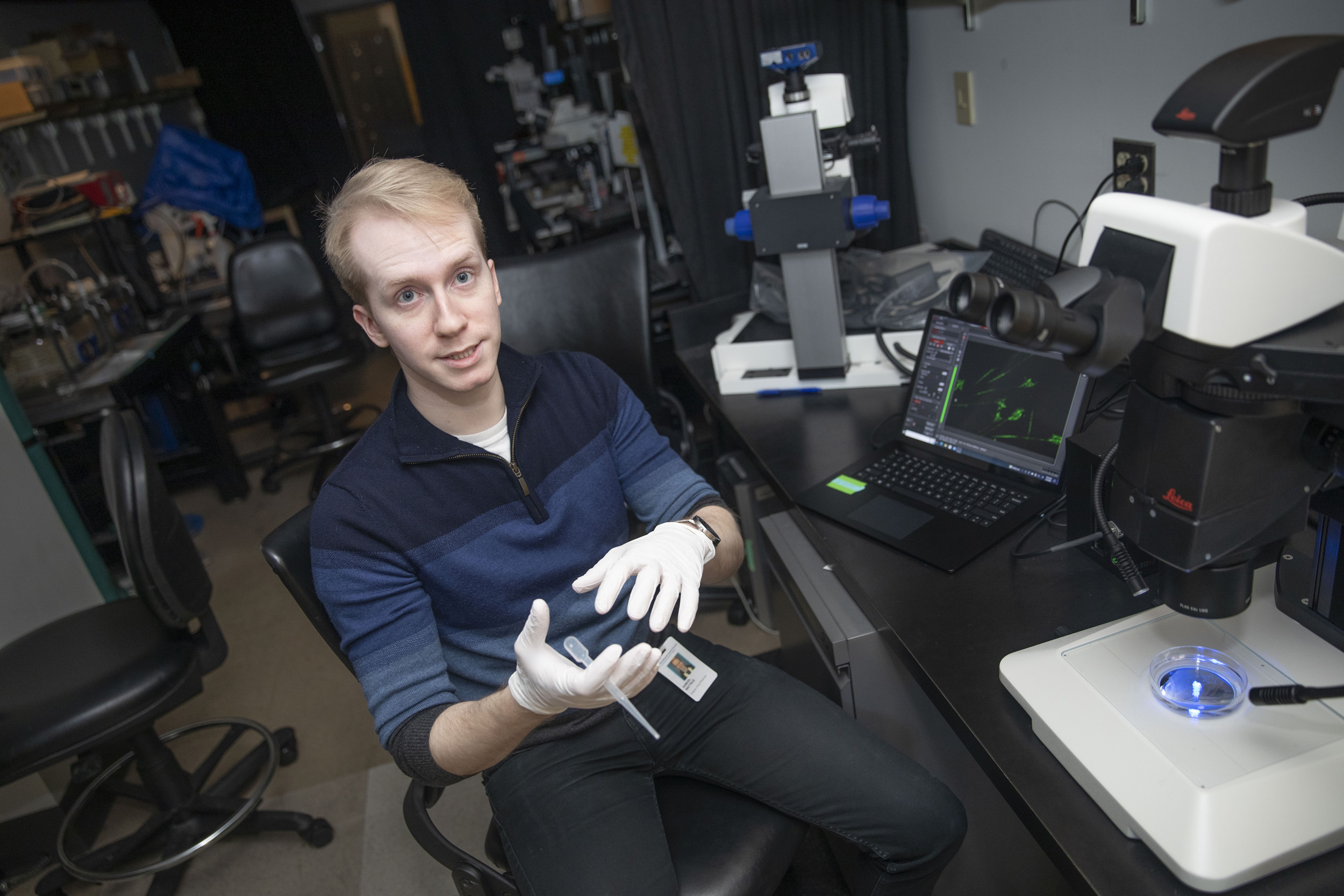
In early 2023, Sam Wattrus ’16, Ph.D. ’22, opened his own lab at Massachusetts General Hospital in the Department of Molecular Biology.
Kris Snibbe/Harvard Staff Photographer
A 14-year incubation
Sam Wattrus becomes first human developmental and regenerative biology concentrator to establish research lab
Sam Wattrus came to Harvard as an undergraduate thinking he would study chemistry. But he took an introductory course in human developmental and regenerative biology (HDRB) when it was a new interdisciplinary concentration in the Faculty of Arts and Sciences.
Now, 14 years after the concentration’s creation, Wattrus ’16, Ph.D. ’22, finds himself in a full-circle moment — as the first alum to establish an independent lab.
“The Stem Cell and Regenerative Biology (HSCRB) Department [the home for the concentration] does an excellent job of training scientists in the ways that they teach and test material,” he said. “They give you data and a scenario and ask you to design an experiment as you would in the lab. It’s open-ended, so you must understand the concepts and apply them. It’s liberating and teaches students how to actually do science.”
Wattrus credits Bill Anderson, the department’s director of education, for leading him toward his eventual career path. “Before taking [the introductory course] SCRB10 with Bill, I had the impression that stem cell biology was a highly esoteric field,” he said. “But Bill is such a great lecturer — he quickly brought me up to speed and helped me engage with complex subject matter.”
While taking the class, Wattrus started working in the lab of Amy Wagers, Forst Family Professor of Stem Cell and Regenerative Biology. “She’s a spectacular mentor,” said Wattrus. “She gave me a lot of opportunity as someone who had never worked in a lab before.”
These two experiences led Wattrus to declare HDRB as his concentration sophomore year, and he began to envision what a career in lab research could look like. Feeling the need to test the waters a bit, Wattrus spent the summer before his junior year working abroad at the University of Cambridge in the lab of John B. Gurdon, a Nobel Prize-winning developmental biologist.
“When I arrived, John asked me to pick up a project someone else had previously been working on,” Wattrus said. “There wasn’t a particular postdoc or graduate student overseeing my work, which was a little jarring at first because I didn’t know how to do everything. But I said to myself, ‘Think of this problem like SCRB10.’ I put myself back in that framework, and it enabled me to work through things.”
“There were multiple faculty I was interested in working with, and Boston is an amazing place to do biology. Several factors, plus a gut feeling, led me to the decision to stick around here.”
Sam Wattrus
Wattrus went on to complete his thesis in the Wagers lab and received a prestigious Thomas Temple Hoopes Prize before graduating in 2016. He returned to Harvard to join the Developmental and Regenerative Biology (DRB) graduate program, where he could dive further into the formation and regeneration of tissues and organisms.
“I liked other programs too, but DRB still ended up being one of my favorites. There were multiple faculty I was interested in working with, and Boston is an amazing place to do biology. Several factors, plus a gut feeling, led me to the decision to stick around here.”
Wattrus knew he still wanted to work on stem cells and development but was interested in expanding his network beyond the Cambridge campus. He leaned on his mentors, Anderson and Wagers, both of whom recommended reaching out to Len Zon, whose lab is based at Boston Children’s Hospital on Harvard’s Longwood campus.
“Len is a great adviser,” said Wattrus. “My time in the Zon lab gave me the opportunity to work with new people in a new environment while staying within the HSCRB community.”
Wattrus investigated the ways blood stem cells in zebrafish embryos interact with immune cells known as macrophages. Using live imaging and cellular barcoding, Wattrus and a team of researchers discovered that macrophages vet stem cells for quality soon after they’re born. They found that cells showing signs of stress were engulfed and eaten by the macrophages, while healthy stem cells were allowed to live and were selectively amplified. They also observed that the stressed stem cells were labeled by a protein called Calreticulin on their surface that acted as an “eat me” signal. Stem cells lacking Calreticulin, or having just small amounts of it, were not eaten and seemed to be encouraged to expand. This work was published in Science late last year.
“We discovered this very cool decision point where the macrophage is directly eliminating a stem cell or selecting it for amplification,” said Wattrus. “From the basic biology side, it’s very interesting, but it could also have implications for problematic cells that are cancerous or precancerous that have similar elevated stress signals. Typically, cancer cells will put up a secondary signal to block the interaction with a macrophage. You could play with those signals to get rid of the cancerous cell that would lead to leukemia or other blood cancers.”
Wattrus defended his dissertation in November 2022, and earlier this year opened his own lab at Massachusetts General Hospital in the Department of Molecular Biology, where he plans to expand on his dissertation work while helping train the next generation of researchers.
Wattrus credits his HDRB coursework and the HSCRB community for helping him get where he is today. “The department also has a wonderful community of grad students and super-supportive faculty who care deeply about teaching and mentoring. You’re not just another person in the lab, and it makes a world of a difference.”





